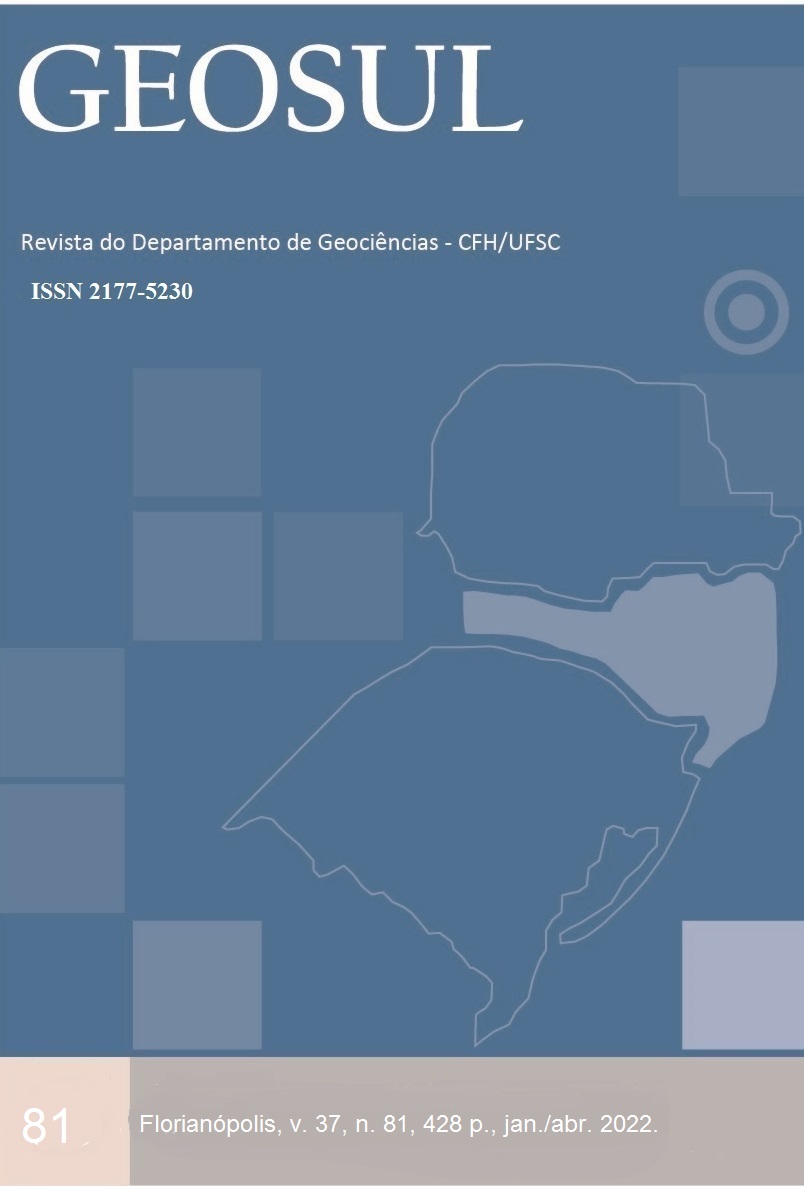Tipologia dos municípios da Amazônia Legal
DOI:
https://doi.org/10.5007/2177-5230.2022.e66047Palavras-chave:
Amazônia Legal, Desmatamento, Aspectos multidimensionaisResumo
O objetivo desse trabalho consistiu em gerar uma tipologia de classificação para os municípios da Amazônia Legal com base em indicadores socioeconômicos e demográficos capazes de representar adequadamente as características da região, possibilitando a construção de uma base territorial de grupos relativamente homogêneos, objetivando, mais particularmente, verificar se era possível identificação de um padrão convergente de municípios convergentes em desmatamento e outros indicadores associados. Foram utilizados 762 municípios que fizeram parte do Projeto de Estimativa do Desmatamento da Amazônia (PRODES) no ano de 2010 e uma base de dados com 19 variáveis abrangendo aspectos econômicos, demográficos, sociais e de posse da terra. Os dados foram submetidos aos métodos multivariados: análise fatorial e análise de agrupamento cluster. Os resultados indicaram como resultado cinco fatores de significado, sendo eles: grau de desenvolvimento médio, desmatamento e seus condicionantes, abertura ao comércio, conservação e direito de propriedades. Os municípios foram, então, agrupados de acordo com os níveis de similaridade, em quatro categorias. Entre os resultados encontrados, o grupo dois destacou-se por ser aquele que mais contém municípios associados a altos valores de desmatamento no ano de 2010.Referências
ALLEN, J. C.; BARNES, D. F. The Causes of Deforestation in Developing Countries. Annals of the Association of American Geographers, v. 75, n. 2, p. 163–184, 1985.
ARAUJO, C. et al. Property rights and deforestation in the Brazilian Amazon. Ecological economics, v. 68, n. 8–9, p. 2461–2468, 2009.
ARCAND, J.-L.; GUILLAUMONT, P.; JEANNENEY, S. G. Deforestation and the real exchange rate. Journal of Development Economics, v. 86, n. 2, p. 242–262, 2008.
BINSWANGER, H. P. Brazilian policies that encourage deforestation in the Amazon. World Development, v. 19, n. 7, p. 821–829, 1991.
BRASIL, A. Atlas do desenvolvimento humano no Brasil 2013. v. 22, 2013.
BRITO, B.; BARRETO, P. Impacts of the new land laws in defining property rights in Pará. Hg. v. IMAZON (State of the Amazon, 15), 2010.
CASTRO, E. Dinâmica socioeconômica e desmatamento na Amazônia. Nova Economia, v. 8, n. 2, p. 5–39, 2005.
COMBES MOTEL, P. et al. Does Land Tenure Insecurity Drive Deforestation in the Brazilian Amazon? [s.l: s.n.].
DADOS 2015. Dados Prodes 2015. Disponível em: http://www.obt.inpe.br/prodes/prodes_1988_2015n.htm.
DAVIES, C. Managing Development: The political dimension. Marc Lindenberg and Benjamin Crosby Kumarian Press, Connecticut, 1981, 217 pp. Public Administration and Development, v. 2, n. 2, p. 191–191, 1982.
DELAZERI, L. M. Determinantes do Desmatamento nos Municípios do Arco Verde--Amazônia Legal: uma abordagem econométrica. Revista Economia Ensaios, v. 30, n. 2, 2016.
EBELING, J. Generating carbon finance through avoided deforestation and its potential to create climatic , conservation and human development benefits. n. February, p. 1917–1924, 2008.
FALLIS, A. . No Title No Title. Journal of Chemical Information and Modeling, v. 53, n. 9, p. 1689–1699, 2013.
FAO. The state of food and agriculture. Rome: Office of Knowledge Exchange, Research and Extension, 2011.
FARIA, W. R.; ALMEIDA, A. N. Relationship between openness to trade and deforestation: Empirical evidence from the Brazilian Amazon. Ecological Economics, v. 121, p. 85–97, 2016.
FEARNSIDE, P. M. Protection of mahogany: a catalytic species in the destruction of rain forests in the American tropics. Environmental Conservation, v. 24, n. 4, p. 303–306, 1997a.
FEARNSIDE, P. M. No Title. v. 55, n. April, p. 17–19, 1997b.
FEARNSIDE, P. M. Land-tenure issues as factors in environmental destruction in Brazilian Amazonia: The case of Southern Pará. World Development, v. 29, n. 8, p. 1361–1372, 2001.
FEARNSIDE, P. M. Desmatamento na Amazônia brasileira: história, índices e conseqüências. Megadiversidade, v. 1, n. 1, p. 113–123, 2005a.
FERNSIDE, P. M. Posse da terra e destruição. O Liberal, p. 185–189, 2009.
FERREIRA, S. Deforestation, Property Rights, and International Trade. Land Economics, v. 80, n. 2, p. 174–193, 2004.
HAIR, J. F. et al. Multivariate Data Analysis. 4th. ed. New Jersey: Prentice Hall: [s.n.].
HENDERSON, R. M.; CLARK, K. B. Architectural Innovation: The Reconfiguration of Existing Product Technologies and the Failure of Established Firms. Administrative Science Quarterly, v. 35, n. 1, p. 9–30, 1990.
IBGE. Instituto Brasileiro de Geografia e Estatística, [s.d.].
JOHNSON, R. A.; WICHERN, D. W. Applied multivariate statistical analysis. 6th. New Jersey, US: Pearson Prentice Hall, 2007.
KAIMOWITZ, D.; ANGELSEN, A. Economic Models of Tropical Deforestation A Review. [s.l: s.n.]. v. 6
MCALPINE, C. A. et al. Increasing world consumption of beef as a driver of regional and global change: A call for policy action based on evidence from Queensland (Australia), Colombia and Brazil. Global Environmental Change, v. 19, n. 1, p. 21–33, 2009.
MENDELSOHN, R. Property Rights and Tropical Deforestation. Oxford Economic Papers, v. 46, p. 750–756, 1994.
MINGOTI, S. A. Análise de dados através de métodos de estatística multivariada: uma abordagem aplicada. [s.l.] Editora UFMG, 2005.
PRODES:MONITORAMENTO DA FLORESTA AMAZÔNICA POR SATÉLITE. Dados PRODES. Disponível em: http://www.dpi.inpe.br/prodesdigital/prodesmunicipal.php.
SANT´ANNA, A. A.; YOUNG, C. E. F. Direitos de Propriedade, desmatamento e Conflitos rurais na Amazônia. Economia Aplicada, v. 14, n. 3, p. 381–393, 2010.
Downloads
Publicado
Edição
Seção
Licença

Este trabalho está licenciado com uma Licença Creative Commons - Atribuição 4.0 Internacional.





